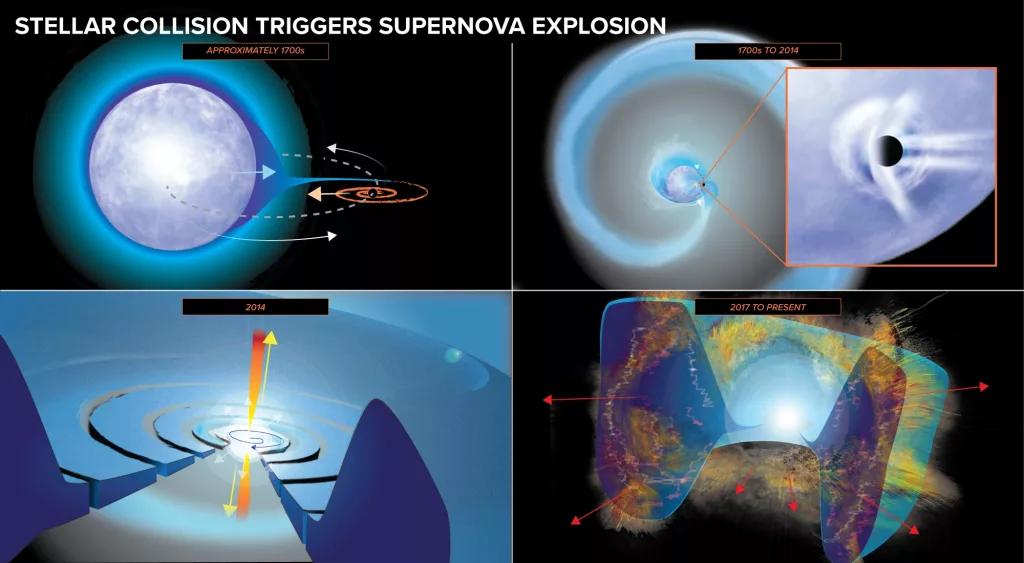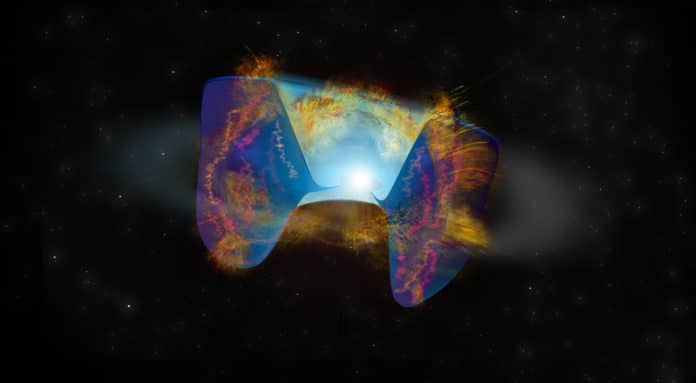A new study offers a direct evidence that a black hole or neutron star spiraled its way into the core of a companion star. Also, it has caused that companion to explode as a supernova. This is the first time that astronomers have seen such an event directly.
The data for the study was obtained from the Very Large Array Sky Survey (VLASS). Observation of images from VLASS gives scientists a clue about an object brightly emitting radio waves. The object was not appeared in an earlier VLA sky survey, called Faint Images of the Radio Sky at Twenty centimeters (FIRST).
Scientists later made further observations of VT 1210+4956 using the VLA and the Keck telescope in Hawaii. They found that the bright radio emission was coming from the outskirts of a dwarf, star-forming galaxy some 480 million light-years from Earth.
In 2014, an instrument aboard the International Space Station detected a burst of X-rays coming from the object.
The data from all these observations allowed astronomers to piece together the fascinating history of the centuries-long death dance between two massive stars. These stars were born as a binary pair, closely orbiting each other.
One of the stars was more massive than the other. It must have evolved through its normal, nuclear fusion-powered lifetime more quickly and exploded as a supernova, leaving behind either a black hole or a superdense neutron star.
The obit of the black hole or neutron star constantly grew towards its companion. About 300 years ago, it entered the companion’s atmosphere, starting the death dance. At this point, the interaction started emitting gas out of the companion into space. With time, the emitting gas formed an expanding, donut-shaped ring, called a torus, around the pair.

In this way, the black hole or neutron star made its way inward to the companion star’s core. It also disrupts nuclear fusion producing the energy that kept the core from collapsing of its gravity.
As the core collapsed, it momentarily formed a disk of material orbiting the gatecrasher. It pushed a fly of material outward from the disk at speeds moving toward that of light, boring its direction through the star.
Dillon Dong, a graduate student at Caltech, said, “That jet is what produced the X-rays seen by the MAXI instrument aboard the International Space Station, and this confirms the date of this event in 2014. The collapse of the star’s core caused it to explode as a supernova, following its sibling’s earlier explosion.”
“The collapse of the star’s core caused it to explode as a supernova, following its sibling’s earlier explosion.”
“The companion star was going to explode eventually, but this merger accelerated the process.”
Gregg Hallinan of Caltech said, “All the pieces of this puzzle fit together to tell this amazing story. The remnant of a star that exploded a long time ago plunged into its companion, causing it, too, to explode.”
“The key to the discovery was VLASS, which is imaging the entire sky visible at the VLA’s latitude — about 80 percent of the sky — three times over seven years. One of the objectives of doing VLASS is to discover transient objects, such as supernova explosions, that emit brightly at radio wavelengths. This supernova, caused by a stellar merger, however, was a surprise.”
“Of all the things we thought we would discover with VLASS, this was not one of them.”
Journal Reference:
- D. Z. Dong, E. Nakar et al. A transient radio source consistent with a merger-triggered core-collapse supernova. DOI: 10.1126/science.abg6037
